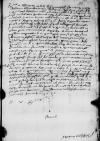Tertiae iam hae sunt, quas ad Dominationem Vestram Reverendissimam post discessum meum a curia eiusdem Dominationis Vestrae Reverendissimae do litteras, nullas vero hactenus neque dominus ⌊orator⌋, neque ego [Dominationis] Vestrae Reverendissimae on the margin⌈Dominationis hidden by binding⌈[Dominationis]Dominationis hidden by binding⌉ Vestrae Reverendissimae[Dominationis] Vestrae Reverendissimae on the margin⌉ vidimus litteras.
Interim tamen nobis relatum est Dominationem Vestram Reverendissimam nuptiis s(erenissimae) ⌊reginae Poloniae⌋[1] summo cum decore et gaudio interfuisse celebrioresque reddidisse. Id quod valde gavisi sumus.
In prioribus meis litteris scripsi Dominationi Vestrae Reverendissimae me decrevisse in reditu permanere in curia s(erenissimi) ⌊regis Romanorum⌋ et commendaticias ad quosdam magnates a Dominatione Vestra Reverendissima petii. Quae, si scriptae sunt, proderunt in posterum. Nunc autem et domino ⌊oratori⌋, et mihi sic consultum visum est, uti hic aliquamdiu p written over r⌈rpp written over r⌉ermanerem. Dabo igitur operam, ut Dominatio Vestra Reverendissima commodiori aliique domini et amici mei commodiori olim servitore uti possint.
Quae hoc toto tempore acta sunt et adhuc aguntur, dominus ⌊Fabianus⌋, ut opinor, satis abunde Dominationi Vestrae Reverendissimae perscripsit. Nos certe miseriarum satis perpessi sumus, sed bene evenit, qui vivi enatavimus, interierunt enim plurimi fortissimi viri, inter quos fidelissimus mihique amicissimus Henricus de Cobolencz quoque periit, [servi]tor Dominationis Vestrae Reverendissimae on the margin⌈servi hidden by binding⌈[servi]servi hidden by binding⌉tor Dominationis Vestrae Reverendissimae[servi]tor Dominationis Vestrae Reverendissimae on the margin⌉. Cuius manibus Deus sit propitius.
Res meae, in ⌊castro⌋ Dominationis Vestrae Reverendissimae Lubaviensi relictae, Dominatio Vestra Reverendissima, plurimum rogo, mandare dignetur, ut per occasionem ⌊Thoroniam⌋ in domum domini doctoris ⌊Hieronimi⌋ deportentur, scripsi enim ⌊patri⌋, quod ibi invenientur. Quod Dominationem Vestram Reverendissimam pro singulari eius in me gratia omnino facturam confido.
Cui me cum servitiis meis etiam atque etiam commendo roque rogoque obnixissime, det huic rudi meae et lituris plenae scriptioni veniam.


 AAWO, AB, D. 4, f. 72v
AAWO, AB, D. 4, f. 72v